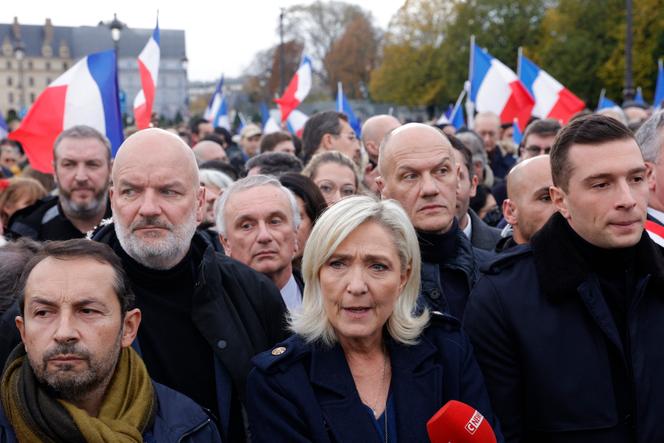


The image will go down in history well beyond this autumn. On Sunday, November 12, among the hundred thousand or so people marching in Paris "for the Republic and against anti-Semitism," Marine Le Pen, leader of the 88 Rassemblement National (RN) MPs, marched at the end of the procession, alongside Jordan Bardella, president of the RN, and elected members of the far-right party wearing their blue, white and red scarves.
A "staggering presence," said historian Grégoire Kauffmann in Le Monde the same day, adding that "a glass ceiling has exploded." "The incredible novelty," he stresses, "is of course the fact that the RN has been invited to join the great Republican family" and this civic march launched by the presidents of the Assemblée Nationale and the Sénat.
In a column published the following day, Solenn de Royer observed that "several political leaders," including Edouard Philippe and Nicolas Sarkozy, have endorsed the RN's presence "without batting an eyelid." "Even though she has kept a low profile, Marine Le Pen can already reap political gains," wrote the journalist, "as her political party has taken another step forward in the process of dédiabolisation she has put in place."
The word "dédiabolisation" – "de-demonization" – first appeared in the pages of Le Monde on September 2, 1989. In that issue's article by Olivier Biffaud, the neologism was accompanied by quotation marks – anything but a detail. "The National Front [former name of the RN until 2018, FN] has been 'demonized' [diabolisé] for several years. It is now undertaking its 'dédiabolisation.' This, in essence, is the message that the leaders of the far-right movement have been trying to get across to their cadres since the start of the summer university they are holding in La Baule," wrote the special correspondent for the Loire-Atlantique (western France) department. Therefore, the concept was pioneered by the FN, the forerunner of the RN. Bruno Mégret, then the party's delegate general, was one of the architects of this "theoretical counter-offensive."
In his article, Biffaud doesn't remind us of what every reader of the time would have already known: Jean-Marie Le Pen, the FN's longtime leader, caused outrage in 1987 by calling the gas chambers a "detail" of the Second World War. Then, the following year, after receiving 14.5% of the vote in the first round of the presidential election, he caused another scandal by nicknaming a minister "Monsieur Durafour-Crematorium." The journalist noted that, at La Baule, FN leaders attacked "egalitarianism" and the "pseudo-philosophy of the Enlightenment."
You have 65% of this article left to read. The rest is for subscribers only.
